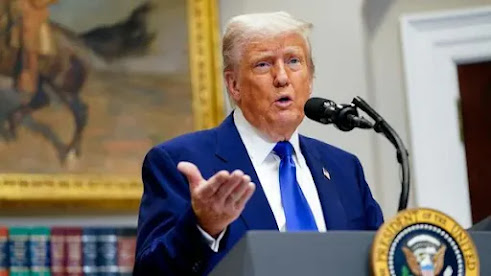Trump's media venture dives deeper into crypto as Truth Social joins the Bitcoin ETF race — is this the turning point for political power and digital assets?
Trump's media venture dives deeper into crypto as Truth Social joins the Bitcoin ETF race — is this the turning point for political power and digital assets?

🧠 Introduction: Politics Meets Crypto
In a world where politics and finance rarely overlap peacefully, Donald Trump’s Truth Social just blurred that line — and in a big way. The social media platform, which has been Trump's flagship alternative to Big Tech giants, is officially stepping into the world of Bitcoin ETFs.
Yes, you read that right.
Truth Social’s parent company has filed to launch a Bitcoin exchange-traded fund (ETF) — a move that signals not only Trump’s growing interest in the crypto space but also a broader mainstream shift that could change the perception of digital assets in the U.S. and beyond.
So, what does this really mean? Why now? And how could this affect the crypto market, especially for retail investors and enthusiasts?
Let’s break it all down — in simple, beginner-friendly language.
💹 What Is a Bitcoin ETF and Why It Matters
A Bitcoin ETF (Exchange-Traded Fund) allows people to invest in Bitcoin without actually owning or storing the digital currency themselves. Instead, it tracks the price of Bitcoin and can be bought/sold like regular stocks on stock exchanges.
Why this is a big deal:
-
No need to manage wallets or private keys
-
Available via traditional brokerage platforms
-
Regulated under financial laws, which builds trust for retail investors
So when a big name files for a Bitcoin ETF, it’s not just paperwork — it’s a signal to the world that crypto is becoming more “mainstream”.
🔍 Truth Social’s Crypto Strategy: Not Just Talk, It’s Action
Truth Social, launched by Trump Media & Technology Group (TMTG), has already been in the news for its political influence and conservative platform. But now, the company is taking a bold turn toward financial innovation.
As per the filing, the ETF would be called “Truth Bitcoin ETF” (tentative), and it aims to give traditional investors easy access to Bitcoin exposure.
This isn’t a PR stunt. It’s a calculated step that:
-
Aligns with the growing U.S. interest in digital assets
-
Strengthens Truth Social’s identity as not just a media company, but a tech-forward movement
-
And possibly, positions Donald Trump as a crypto-friendly political figure — a sharp contrast to regulators who are still skeptical
🧨 Trump’s Relationship with Crypto: Changing Tides?
It’s interesting to note that Donald Trump wasn’t always pro-crypto.
In fact, during his presidency, he once called Bitcoin a “scam” and warned about its use in illegal activities. But fast forward to 2024–25, and the man who once dismissed it is now indirectly supporting it through his companies.
Why the change?
-
Mass adoption: With global institutions, including BlackRock and Fidelity, filing for Bitcoin ETFs — it’s no longer “nerd money.” It’s real, institutional finance.
-
Political advantage: As crypto becomes a hot-button issue, supporting it could attract younger, tech-savvy voters.
-
Diversification: Truth Social needs to stand out — and entering crypto makes it more than just a Twitter alternative.
📊 What Could This Mean for the Market?
Whenever a big name enters crypto, especially in the form of a Bitcoin ETF, the market tends to respond with optimism. Why?
Because it suggests:
-
Legitimacy: The more regulated players join in, the harder it becomes to deny crypto’s place in finance
-
Liquidity: ETFs attract institutional investors, bringing billions into the market
-
Price boost: More demand usually leads to price rallies (though short-term volatility remains)
Even if you’re in India or outside the U.S., these movements set the tone globally.
🇮🇳 How Indian Crypto Enthusiasts Should View This Move
Though India hasn’t approved any Bitcoin ETFs yet, investors here can still gain a lot by understanding what’s happening:
-
Global Sentiment: If ETFs are being approved in the U.S., it increases the chances of more lenient regulations in other countries too.
-
Investment Opportunity: Indian investors using international platforms (like Interactive Brokers) can gain exposure to such ETFs in the future.
-
Regulatory Pressure: Moves like this could push Indian regulators to rethink their conservative stance on crypto.
And let’s not forget — crypto is borderless. A policy move in the U.S. affects the entire world.
🔍 A Quick Look at the Bitcoin ETF Race
Trump’s Truth Social is not the only one in the race.
Here are a few key players already in the ETF scene:
| Company | ETF Name | Status |
|---|---|---|
| BlackRock | iShares Bitcoin Trust | Approved |
| Fidelity | Wise Origin Bitcoin | Approved |
| Valkyrie | Bitcoin Strategy ETF | Live on Nasdaq |
| Grayscale | GBTC | Converted to ETF |
| Truth Social | Truth Bitcoin ETF | Just Filed 🆕 |
💬 What Industry Experts Are Saying
💡 James Butterfill, crypto strategist at CoinShares:
“A Trump-backed ETF could open new doors. It’s not just financial — it’s cultural.”
💡 Raoul Pal, ex-Goldman Sachs fund manager:
“The U.S. is waking up. Truth Social entering crypto is proof that Bitcoin is now part of the mainstream narrative.”
🧭 Final Thoughts: Is This the Future of Crypto in Politics?
In a world increasingly driven by innovation, politicians can no longer ignore crypto. The filing of a Bitcoin ETF by Trump’s Truth Social is more than just business — it’s a message:
"Crypto is here, and we’re not sitting on the sidelines anymore."
For investors, it means more legitimacy.
For traders, it could mean new price action and volatility.
For believers in decentralization, it’s proof that we’re winning.
FREE Online Trading Courses - Download
QNA
1. Is bitcoin worth investing in?
2. Is it safe to invest in Bitcoin or is it just a bubble?
3. What is bitcoin? How does it work? How do I invest money .










